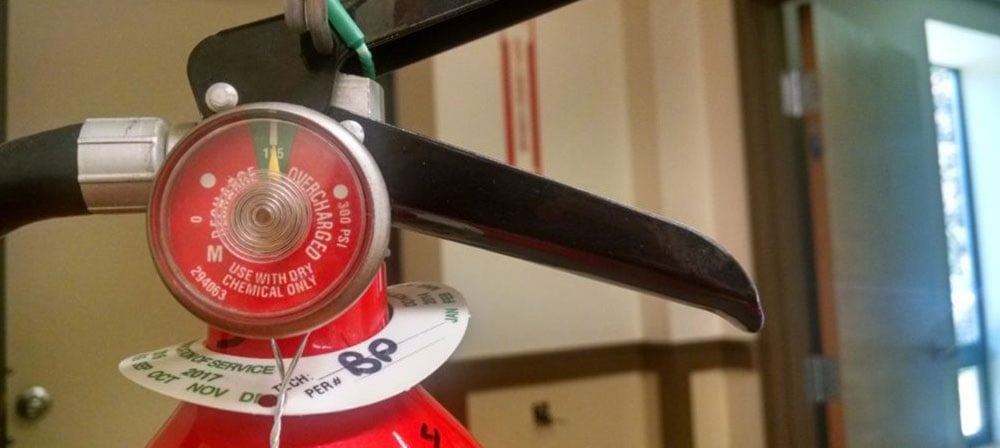Portable fire extinguishers are one piece of equipment we often take for granted. You may think your fire extinguisher is always ready and waiting to be called into service. But if you haven't inspected the extinguisher recently, it may not be as operational as you think—and could even pose a danger to you or others attempting to use it.
Most portable fire extinguishers come with a pressure gauge that indicates whether or not the extinguisher is properly pressurized. If the indicator points to "Recharge," the pressure in the extinguisher is too low to expel the chemical that extinguishes the fire. An undercharged or depressurized fire extinguisher endangers the lives of your personnel and the surrounding property.
Why Fire Extinguishers Lose Pressure Over Time
Portable fire extinguishers are metal cylinders filled with water or chemical material (the extinguishing agent). They are then pressurized with an expelent gas, normally dry nitrogen or dry air, within the same cylinder. The extinguisher valve and its related components keep the compressed gas from escaping until operated.
Over time, like an old or worn car tire, a fire extinguisher can develop a slow leak that releases the gas. When this happens, fire extinguisher depressurization occurs. This process can be due to a leaky or damaged valve component such as an O-ring seal or valve stem. Damage to the cylinder itself can also cause slow leaks.
Dig Deeper
HOW TO CHOOSE THE RIGHT FIRE EXTINGUISHER
Learn three critical considerations to keep in mind when choosing a suitable fire extinguisher for your needs. Learn More →
The Dangers of Depressurized Fire Extinguishers
While a leaking or depressurized fire extinguisher isn't dangerous in and of itself (the gas won't cause damage to people, for example), its dangers are nevertheless severe. A lack of pressure causes a fire extinguisher to be inoperable.
When fighting incipient-stage fires, every second matters. The fire gets more extensive and more challenging to control as time passes. Time spent looking for a functional extinguisher, or an alternative way to extinguish the fire is time wasted, which could have been spent on mitigation efforts. Depressurization is even more dangerous in some cases, such as cooking fires, as these fires can't be extinguished with water. If a suitable fire extinguisher is unavailable, you're putting your property, assets, and building occupants at a greater risk.
Fortunately, simple visual inspections can help keep you prepared. Once a month, check your fire extinguisher to ensure the pressure gauge is in the proper position and that there are no signs of physical damage. Most property owners aren't this diligent. However, they should at least look at them semi-annually when changing the batteries in their smoke and Carbon Monoxide (CO) detectors.
Remember, fire extinguishers must be recharged by trained fire protection professionals to meet NFPA 10, state codes, OSHA requirements, and insurance company recommendations.
Related Resource
FIRE EXTINGUISHER RECHARGING: WHAT EVERYONE SHOULD KNOW
Familiarize yourself with the fire extinguisher recharging process. Learn More →
What to Do When Fire Extinguisher Depressurization Occurs
Even the most well-maintained devices deteriorate, depressurize, and reach the end of their shelf life. If you notice that the pressure gauge on your portable extinguisher is in the "Recharge" position or is reading in the "Over Pressurized Range," the best thing to do is to get in touch with an experienced fire protection company.
A fire protection professional will inspect your extinguisher, ensuring it's safe to recharge. Then, technicians will perform the refilling process for you at minimal time and cost. If the extinguisher is damaged or unsafe to recharge, a fire and life safety technician will recommend an appropriate replacement.
Editor's Note: This post was originally published on April 3, 2017, and has been updated for accuracy and current best practices.








